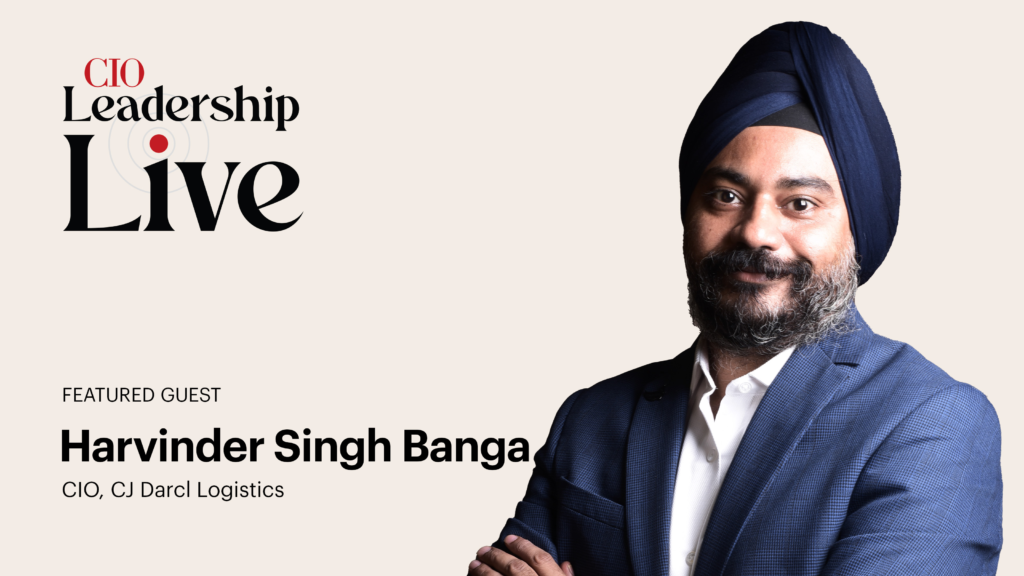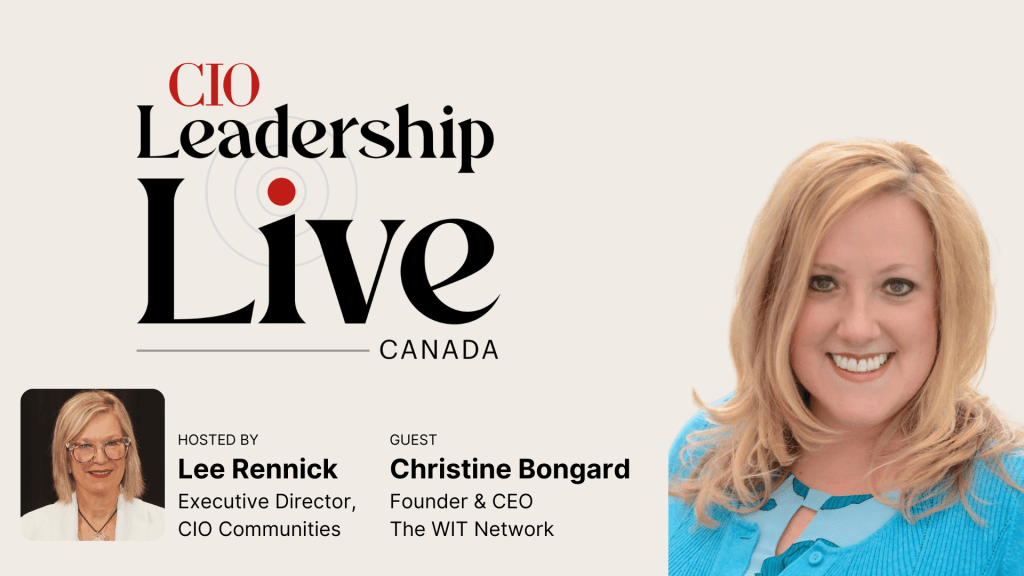00:00 100:00:03,966 –> 00:00:06,000Welcome to CIO Leadership Live.200:00:06,000 –> 00:00:10,133I’m Lee Rennick, executive directorof CIO communities for cio.com,300:00:10,366 –> 00:00:13,233and I’m very excited and honored todayto welcome Christine400:00:13,233 –> 00:00:16,500Bongard,CEO, co-founder of the WIT Network.500:00:16,800 –> 00:00:17,800Christine.600:00:17,800 –> 00:00:20,500Please introduce yourselfand welcome to the show.700:00:20,500 –> 00:00:20,933Hi there.800:00:20,933 –> 00:00:22,833Lee, thank you so much for having me ontoday.900:00:22,833 –> 00:00:26,500Yes. Christine Bongard,CEO and co-founder of the WIT network.1000:00:27,266 –> 00:00:30,000I have been a woman in technologymy whole career.1100:00:30,000 –> 00:00:33,933I had the fortunate, fortunate experienceof being part of a Techstars1200:00:34,033 –> 00:00:38,866up in the New York metro areaand, had the opportunity to grow business1300:00:38,866 –> 00:00:42,300from start and learn all about everything1400:00:42,333 –> 00:00:45,600technology, how to manage teams,how to run a business.1500:00:45,600 –> 00:00:49,100It was just such an incredible opportunityfor me1600:00:49,400 –> 00:00:52,500and, thatthat led me to being a woman in tech.1700:00:52,833 –> 00:00:57,733And I got to build a great network,over all of that time and,1800:00:58,933 –> 00:00:59,733have the fortunate1900:00:59,733 –> 00:01:03,600experience to then take my, careeras an entrepreneur2000:01:03,600 –> 00:01:08,100and in the tech industry and builda global network for women in tech.2100:01:08,466 –> 00:01:10,366as my my second part of my career.2200:01:10,366 –> 00:01:11,700So loving it.2300:01:11,700 –> 00:01:14,366Wow. Wow, that sounds really amazing.2400:01:14,366 –> 00:01:16,000And we’ll dive into thata little bit more.2500:01:16,000 –> 00:01:18,000And, you know, I’ma member of the Witt network.2600:01:18,000 –> 00:01:21,166Our organization is, I’m so proud that2700:01:21,166 –> 00:01:24,166we have that connectionwith this organization.2800:01:24,166 –> 00:01:26,433and all thatyou do to ensure that women have a safe2900:01:26,433 –> 00:01:29,433place,a place to network and learn and share.3000:01:29,433 –> 00:01:32,133And, so I’m looking forwardto having this interview today.3100:01:32,133 –> 00:01:35,200So I really do appreciate youjoining us today.3200:01:35,200 –> 00:01:36,266Christine, thanks so much.3300:01:36,266 –> 00:01:39,800We have created this seriesto support diversity in technology3400:01:40,000 –> 00:01:43,000and really listen to womenworking in this space.3500:01:43,066 –> 00:01:45,900and how, you know, they’re buildingand supporting out,3600:01:45,900 –> 00:01:48,833other women in, in, in our industry.3700:01:48,833 –> 00:01:51,833And so the first questionand I ask everyone this question,3800:01:52,233 –> 00:01:55,566could you please tell us a little bitabout your own career path and maybe3900:01:55,566 –> 00:01:59,166provide some insights or tips on that rolepath, especially as a women woman?4000:01:59,166 –> 00:02:02,133Excuse me, are there any lessons sharedthat you could, you know,4100:02:02,133 –> 00:02:03,900any lessons learned that you could share?4200:02:03,900 –> 00:02:05,500So a couple of things.4300:02:05,500 –> 00:02:05,966You know, as4400:02:05,966 –> 00:02:10,466I mentioned, just a great opportunityto come up in tech throughout my career.4500:02:10,466 –> 00:02:13,866And I will say thatjust about the whole way through,4600:02:14,300 –> 00:02:18,500I was, consistently one of the only womenin the room, whether we were4700:02:18,500 –> 00:02:23,000with a customer, a partner,at a conference, at networking events,4800:02:23,933 –> 00:02:26,933you know, leads to feeling isolated.4900:02:27,066 –> 00:02:31,733and, you know, some of those eventswere golf events and whiskey tastings5000:02:31,733 –> 00:02:36,666and cigar, events, and those were thingsI really couldn’t relate to.5100:02:36,666 –> 00:02:39,300And, you know,it was hard to break into conversations5200:02:39,300 –> 00:02:42,166with people and I thought,where were the women?5300:02:42,166 –> 00:02:43,200You know, we have to5400:02:43,200 –> 00:02:46,766the technology industry is suchan incredible place to be.5500:02:47,166 –> 00:02:51,066And, you know, just felt like,how do we bring more women into this5600:02:51,066 –> 00:02:54,766and, and make, you know,bring gender parity to these events?5700:02:55,066 –> 00:02:59,000so that you mentioned the word safe,you know, so that that women feel5800:02:59,000 –> 00:03:03,500more comfortable, you know, being in,being in the room and being present.5900:03:03,500 –> 00:03:07,666So, you know,I really took those experiences that6000:03:07,666 –> 00:03:11,566that fueled, my need to, to want to bea part of starting this network.6100:03:11,966 –> 00:03:14,533But you asked about, you know,what are some lessons learned?6200:03:14,533 –> 00:03:16,366And I would say, you know, given6300:03:16,366 –> 00:03:20,166that we haven’t seen a ton of changein the numbers for gender parity,6400:03:20,433 –> 00:03:24,566in this industry,you have to really be bold and go for it.6500:03:24,566 –> 00:03:29,133And, you know, I think, you know,sitting back and kind of waiting for6600:03:29,366 –> 00:03:33,266career paths to materializein front of you or for your manager6700:03:33,533 –> 00:03:38,666to take the time to help you build it out,or for even HR teams to, to do that.6800:03:38,666 –> 00:03:39,966We’re we’re in a,6900:03:39,966 –> 00:03:43,133we’re in a place now in the worldwhere they just don’t have the time7000:03:43,133 –> 00:03:44,233to do that stuff. Right.7100:03:44,233 –> 00:03:49,233So I think we have to really inspire womento get clear on their vision.7200:03:49,300 –> 00:03:50,300Where do they want to go?7300:03:50,300 –> 00:03:54,333What skills do they want to build,and then look at the networks around them,7400:03:54,333 –> 00:03:58,800look at, you know, look at wherethey can take advantage of learning.7500:03:59,133 –> 00:04:02,433You know, we’ve got lots of stuffon LinkedIn learning, and there’s lots of,7600:04:02,633 –> 00:04:07,300technology companies and organizationslike the Witt network that provide7700:04:07,500 –> 00:04:11,466skills training and different,you know, educational opportunities.7800:04:11,466 –> 00:04:14,566And so I just really encourage womento be bold.7900:04:14,566 –> 00:04:15,400Go for it.8000:04:15,400 –> 00:04:18,400You know, get out there and and capture,8100:04:18,533 –> 00:04:21,733you know, the skills that they needto help accelerate their careers.8200:04:22,500 –> 00:04:24,066Yeah, I think that’s great advice.8300:04:24,066 –> 00:04:27,600I was just speaking to a friendand colleague about just this very thing.8400:04:27,866 –> 00:04:31,666I have my own personal like networkingbank book that I have on It’s8500:04:31,700 –> 00:04:35,100a rainbow and it’s on my desk,and it’s like I look at it and when I8600:04:35,100 –> 00:04:39,266need those moments to kind of plan and,you know, speak to others.8700:04:39,266 –> 00:04:42,833And I have a business coach I work with,you know, that’s super important.8800:04:42,833 –> 00:04:46,800And I didn’t really learn this until, likenow in life or like, you know, when I,8900:04:47,066 –> 00:04:50,666when I, started working with organizationslike the IT network.9000:04:50,666 –> 00:04:52,933So, it’s really impactful to me.9100:04:52,933 –> 00:04:56,400So maybe we could, we couldthe segue as well into the next question.9200:04:56,700 –> 00:04:59,933could you please tell our audiencea little bit about the Witt network,9300:05:00,333 –> 00:05:01,566you know, what is it?9400:05:01,566 –> 00:05:02,700How is it formed?9500:05:02,700 –> 00:05:06,300And, you know, we talked about thisa little bit, but why it’s important right9600:05:06,300 –> 00:05:09,300now, especially for women in tech,to have organizations like.9700:05:09,600 –> 00:05:12,700Oh, gosh, I could talk about this for,for










